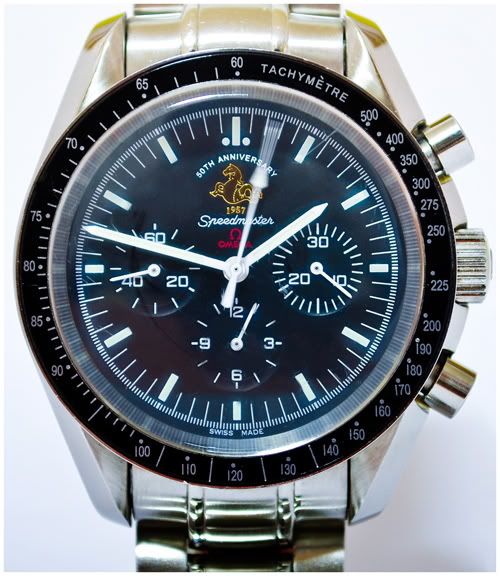My interest in watches were reignited by the publicity surrounding the Omega Speedmaster 50th Anniversary Moonwatch.

It differs from the conventional moonwatch in three ways: one, the patch; two, the sapphire glass as opposed to the usual hexalite crystal (plastic) glass; and three, the limited edition (5,957 pieces)

Apparently, in the mid-60s, five different brands of chronographs were purchased by NASA for testing. The Speedmaster passed NASA's numerous tests, whereas the Rolex, Breitling, Bulova, Longines and Heuer, failed. For owners of Omega, this gives a sense of pride in ownership because Omega was the official moonwatch.
The Rolex GMT however was a favourite among the astronauts and they wore
it to the moon, thus making it the unofficial moonwatch. This automatic has to be wound, as zero-gravity conditions rendered the self-winding mechanism ineffective.
So, here I am, reviving my interest in Rolexes as well.

It differs from the conventional moonwatch in three ways: one, the patch; two, the sapphire glass as opposed to the usual hexalite crystal (plastic) glass; and three, the limited edition (5,957 pieces)

Apparently, in the mid-60s, five different brands of chronographs were purchased by NASA for testing. The Speedmaster passed NASA's numerous tests, whereas the Rolex, Breitling, Bulova, Longines and Heuer, failed. For owners of Omega, this gives a sense of pride in ownership because Omega was the official moonwatch.
The Rolex GMT however was a favourite among the astronauts and they wore
it to the moon, thus making it the unofficial moonwatch. This automatic has to be wound, as zero-gravity conditions rendered the self-winding mechanism ineffective.
So, here I am, reviving my interest in Rolexes as well.


 ... there is something romantic about having a speedie made in the year of the moon-landings ... just before they were staped as being moon watches.
... there is something romantic about having a speedie made in the year of the moon-landings ... just before they were staped as being moon watches.




Comment